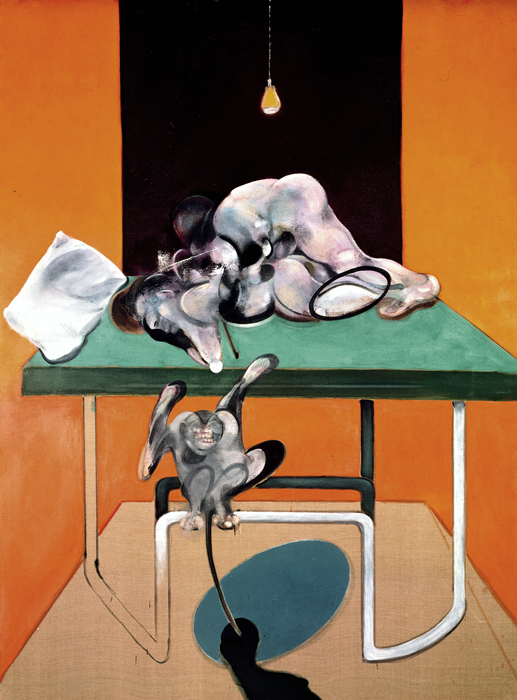‘I just like men. I like their brains, I like the quality of their flesh,’ declares a cheerful Francis Bacon, getting steadily more drunk with an equally pissed Melvyn Bragg, in Bragg’s revealing 1985 South Bank Show documentary on the artist. Bacon, a selection of whose paintings are currently on show at Gagosian London, tended not to make his sexuality a particularly public matter, but nor did he go out of his way to hide it. Coinciding with Pride month, the Gagosian show mostly homes in on those of Bacon’s paintings which depict two (male) bodies together, from the 1950s to the 70s, pivoting around 1967 – the year of the decriminalisation of homosexuality in England and Wales. It’s an intriguing curatorial proposition, not least because it allows one to consider Bacon’s strange and striking approach to figuration in the frame of what could and could not be shown, of bodies, sex and desire, when admitting it was something criminal.

Veiled suggestion is the what drives the earliest paintings here – the famous Two Figures (1953), transposing male wrestlers to the scene of an unmade bed, and Two Figures in the Grass (1954), both retain the intense charge of innuendo, of provoking the viewer’s recognition of something going on that’s not quite visible, but somehow happening in plain sight. Perhaps that’s why Bacon’s gallery didn’t exhibit it publicly when it was made. It’s hard to imagine a time when showing Two Figures could be taking a genuine risk, or that two visitors to Bacon’s 1955 show at the ICA could have reported Two Figures in the Grass to the police.
Thinking of Bacon’s paintings as constantly touching on and circling around what can and cannot be shown, what can and can’t be revealed, opens a different perspective on the artist’s shifting, fugitive representation of the human body. Rather than be explicit in works only shown in private, Bacon was hinting and suggesting in public – a different kind of risk at a time when gay men faced social stigma and criminal punishment. The year that Bacon was painting Two Figures in the Grass, pioneering computer scientist Alan Turing committed suicide, after having suffered a course of ‘chemical castration’, the penalty (instead of prison) for having been prosecuted, two years earlier, for his homosexuality.

Turing’s ‘crimes’ were ones committed in private, behind closed doors. Bacon’s paintings, for their part, continuously transgress the demarcation of public and the private realm, the inside and the outside. The Two Figures may be lying in the grass, but the grass is inside a black, interior space. In the astonishing triptych Three Studies of Figures on Beds (1972), the beds and the figures having sex on them are set up outdoors, or are perhaps indoors behind windows, looking out to what might be buildings on a street, or a beach, against a dull bluish sky. Here, five years after decriminalisation, the sex is as explicit as Bacon gets, erect penises painted unambiguously between the convulsing, intermingling figures on these exposed, hard beds, electric lights above them burning inexplicably in daylight. And just so we get the point, Bacon flecks a squirt of white paint across the middle canvas, a crude, ironic approximation of ejaculation (and a little joke at Jackson Pollock’s expense).
Decades later, Bacon’s paintings remain disconcerting and beguiling, playing subtle games with what we see and what we want to see, with painting’s voyeuristic impulse, the nature of publicness and intimacy, of hiding and exposing, and the ambiguities of human desire. They’re also a reminder, as they hint, suggest and wink at us through their shifting gauzes of paint, of how bad things once were, and how far society has come since.
Francis Bacon: Couplings at Gagosian Grosvenor Hill, London, through 3 August 2019
Online exclusive published on 5 July 2019
